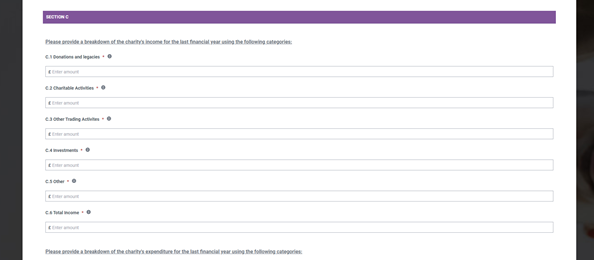Section C

You will now be asked some questions about how your charity is run.
Please click on the expanding sections after it to read more about how to answer a question. Remember, after completing Section C, you will be asked to submit your required documentation.
Your charity’s purpose is stated on the charity’s entry on the Scottish Charity Register.
In order to achieve the purposes stated on the register, does your charity do any of the things in this list? Please tick all the options that apply, and if your charity does any things not listed, please describe these in the space provided under ‘Other’.
This information will be published on the Scottish Charity Register entry for the charity and will help those who are looking at the register to understand more about your charity. You should tell us briefly what the charity is set up to do and the activities it does to achieve this.
If you are part of a larger organisation then you may be provided with standard text from the organisation to complete this question.
(i) Your charity may know the governing document as your constitution, articles, rules or trust deed. If you have made any changes to this in the last year you should select yes. If you have made no changes, please select no.
If you answer yes to this question you will be asked if you have notified us of the change which is made.
(ii) Your charity may know the governing document as a constitution, articles, rules or trust deed. Please tell us when the charity trustees last looked at the governing document and ensured that it remained fit for purpose.
A Scottish Charitable Incorporated Organisation (SCIO) must have at least three charity trustees as stated in the SCIO Regulations. For other legal forms, there is no legal number of charity trustees but it is good practice to have at least three.
Most charity governing documents (your charity may know this document as a constitution, articles, rules or trust deed) will set out a minimum number of charity trustees who must be present to be able to make decisions for the charity.
An induction process is a process by which a new charity trustee learns about their roles and responsibilities. This may include attending a board meeting as an observer, shadowing trustees and/or staff members of the charity. It should also include an opportunity for new trustees to familiarise themselves with the governing document of the charity.
Charity trustees are people involved in the management and control of a charity, you may call yourselves a committee, a board, Directors or something less formal – the charity trustees for the last financial year should be listed in your charity’s Trustees’ Annual Report.
Please tell us about any payment or benefit received by a charity trustee.
Out of pocket expenses paid to charity trustees, for instance travel expenses to attend meetings, should not be included in this section.
In order for us to understand the structure of the charity please select from the following:
- The charity is the parent of a subsidiary body/bodies
- The charity is a subsidiary of a parent body
- Neither of the above
You should answer the question by selecting the appropriate choice of structure for your charity. The charity is a parent of a subsidiary body or bodies if it controls another entity.
Control means that there is the power to govern the financial and operating policies of an entity in order to obtain benefits from its activities. This is usually through the ownership of share capital.
The charity is a subsidiary body if it is controlled by another charity.
Where there is a close relationship with an umbrella charity or a number of funds (such as in a Church) this does not mean that there is a parent or subsidiary.
Your Register entry says that you operate not only in the UK but also abroad. Please list the countries which you operated in out with the UK in the period covered by your accounts.
Please select whether you have controls in place for expenditure which is overseas. Controls will be procedures by which the charity ensures that overseas activities are properly accounted for. They will ensure that any overseas expenditure is properly authorised and reported on.
Once you have completed the questions, click 'Save & Next'.
You will now be asked to submit your required documentation.
